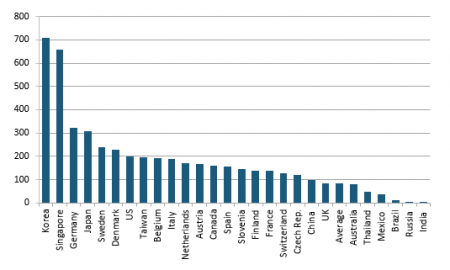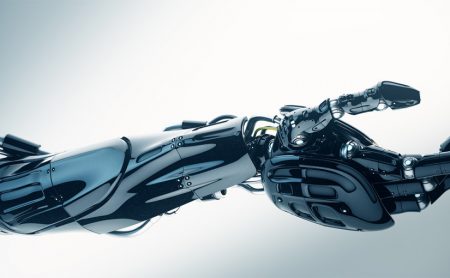April 4, 2019 – The adoption of robots around the world is an uneven experience with Asian countries taking the lead. Korea is the world’s largest adopter with 710 robots per 10,000 workers. Singapore is second. In western countries, Germany ranks first with a little more than 300 robots per 10,000 workers. The United States averages 200 robots per 10,000 workers, and Canada a little over 150 per 10,000. Do these statistics seem counterintuitive? Wouldn’t we expect to see more advanced economies to be the predominant users of robots? But that is not the case when you look at wage levels in Korea and Singapore compared to Germany, the United States, and Canada.

So why is this?
One can make an argument that it is our irrational fear of automation that keeps robotic adoption in Western economies at much lower levels than in Asia. A second reason may be cultural. It appears that Asian countries see robots as socially acceptable, safe and useful companions whether in the workplace or in homes. Instead of robots being seen as job killers they are deemed to be useful machines for improving productivity and lives. Japan holds annual contests to make robots even more useful for its population. There, robots are being used to help the elderly in homes and hospitals. You can even run into an occasional robot pet.
We in the West seem to have no problem sending robots into space to explore the surface of the Moon or Mars. We find them useful for remote sensing in our oceans, or in today’s modern surgical suites where they are being used to perform operations. We even have adopted them to vacuum our homes. And currently, we have millions of vehicles on our roads with all kinds of robotic capabilities from adaptive cruise control to intelligent parking assist. But when it comes to adopting robots in industrial settings there is a general discomfort.
Managing the change that robotics will bring to the world in the 21st century requires us to understand the legal, ethical, and social implications of widespread adoption. In an effort to establish a common approach to regulation, the European Commission funded a study in 2014 called the RoboLaw project. It focused on legal status, nanotechnologies, brain-computer interfaces, neuroprosthetics, as well as more conventional robotic arms, pallets, and devices used in manufacturing. In the end, a set of rules were proposed that could be turned into legislation for countries within the European Union to establish a regulatory landscape and methodology to use as robotics and its companion technology, artificial intelligence (AI), continue to evolve.
The RoboLaw project defined robots by various taxonomies including:
- Matter or embodiment referring to the physical definition of what embodies a robot. Robot forms include mechatronic machines, AI software, and hybrid systems that combine biology with mechatronics and AI.
- Level of Autonomy referring to the power to influence or direct a robot’s behaviour including a range from full autonomy to shared control.
- Function referring to the task for which the robot is designed including a variety of industrial applications, service applications, and other uses whether in the presence of humans or for use in uninhabited environments.
- Environment referring to the operating surroundings or conditions for which the robot is designed.
- Human-robot interaction referring to the types of relationships that could exist between humans and robots and the communication and collaboration between them.
It then applied the taxonomies to case studies to determine the potential human impacts, for example, the use of a surgical robot to save a human life, a companion robot that helps someone who is bedridden, a deep-learning robot used to analyze massive amounts of data to find commonality, a prosthetic limb to replace a missing human one, an exoskeleton to give a paraplegic the ability to walk, a nanorobot that operates inside a person to hunt down cancer cells, or to repair a damaged organ or blood vessel, and robot integration for the purpose of human enhancement.
Do the RoboLaw project results help to reduce our fear of a future where robots will increasingly be part of our world? I believe so. By establishing a well-defined regulatory environment it should make incorporating these machines into our everyday lives a far more seamless effort.
The image of robots we fear, The Terminator, represent a very small segment of what will be a ubiquitous technology. The few designers building animatronic robots resembling humans represent novelty rather than purposeful function. I would suspect that the vast majority of our 21st-century robots will be more like Roombas which don’t look anything like a person pushing a vacuum cleaner.









